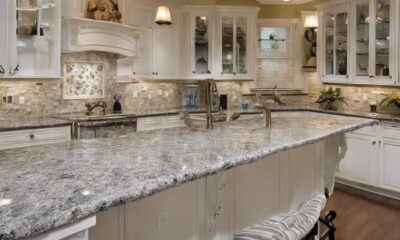Beginners Guides
What Temp for Griddle for Pancakes
2025
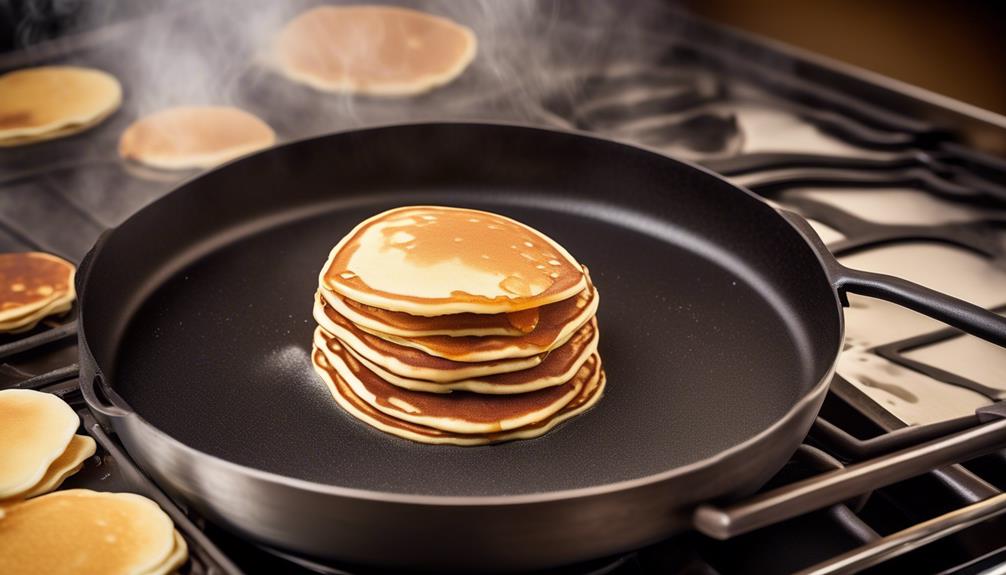
Have you ever questioned why certain pancakes come out perfectly golden while others are unevenly cooked? We’ve all experienced this dilemma, attempting to discover the ideal griddle temperature for the perfect pancake.
But fear not, because we're here to guide you through the science of pancake perfection. Understanding the ideal temperature for your griddle is the first step to achieving those dreamy, fluffy pancakes that everyone loves.
So, let's dive into the intricacies of griddle temperatures and discover the secrets to pancake perfection.
Key Takeaways
- Maintaining the correct griddle temperature is crucial for perfectly cooked pancakes.
- Consistency in griddle temperature ensures a golden brown color and fluffy texture.
- Different areas of the griddle have different temperatures, allowing for precise control over the cooking process.
- Adjusting the griddle temperature is necessary for different types of pancakes to achieve the desired texture and flavor.
Importance of Griddle Temperature
Maintaining the correct griddle temperature is crucial for achieving perfectly cooked pancakes with a golden-brown exterior and a fluffy interior. Cooking techniques play a significant role in ensuring that the pancakes turn out just right. When the griddle is too hot, the pancakes may burn on the outside while remaining raw inside. On the other hand, if the griddle isn't hot enough, the pancakes will take longer to cook, resulting in a pale and dense texture.
To achieve the ideal griddle temperature, preheat the griddle over medium heat for about 5-10 minutes until it reaches around 375°F. This allows for even cooking and ensures that the pancakes are cooked through without burning.
Furthermore, recipe variations can also impact the griddle temperature needed for the perfect pancakes. Thicker batters or those with add-ins like chocolate chips or fruits may require a slightly lower temperature to allow the insides to cook without burning the exterior. Conversely, thinner batters may benefit from a slightly higher griddle temperature to facilitate a faster cooking process.
Understanding these cooking techniques and recipe variations empowers us to master the art of making consistently delicious pancakes.
Finding the Sweet Spot
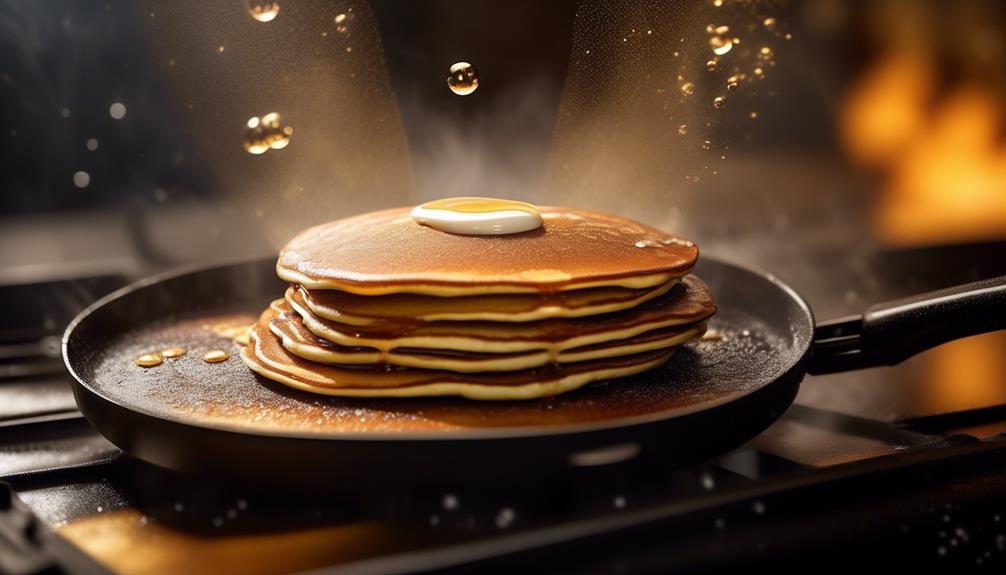
Understanding the impact of recipe variations on griddle temperature is essential for finding the sweet spot in achieving perfect pancakes. Finding consistency in griddle temperature is crucial to ensuring that each pancake turns out with the perfect golden brown color and deliciously fluffy texture. To achieve this, it's important to consider the type of griddle being used, the heat source, and the pancake batter's composition. Here's a quick reference table to help you find the sweet spot for your pancake griddle temperature:
| Griddle Type | Ideal Temperature Range |
|---|---|
| Cast Iron | 350°F – 375°F |
| Non-Stick | 325°F – 350°F |
Maintaining the griddle within these temperature ranges will help you consistently achieve the perfect golden brown pancakes. It's important to allow the griddle to preheat properly and to make minor adjustments to the temperature as needed. Once you find the ideal temperature for your setup, you'll be able to create delicious pancakes time and time again.
Understanding Heat Zones
To grasp the concept of heat zones on a griddle, it's essential to understand how different areas of the cooking surface can affect the cooking process. Griddle control is crucial for achieving the perfect pancake. The heat distribution on a griddle can vary, with some areas being hotter than others. This difference in temperature across the surface creates distinct heat zones that can be utilized for different purposes.
Understanding heat zones allows for precise control over the cooking process. For instance, the center of the griddle tends to be the hottest spot, making it ideal for quickly searing foods or achieving a golden brown crust on pancakes. The outer edges, on the other hand, may be cooler, which is advantageous for keeping finished pancakes warm without overcooking them.
Mastering heat zones on a griddle enables chefs to manage multiple tasks simultaneously. By utilizing the various temperature zones, it's possible to cook different foods at the same time, such as bacon on the hotter section while gently warming pancakes on the cooler area. This level of griddle control and understanding of heat distribution empowers cooks to achieve optimal results with precision and efficiency.
Adjusting for Different Pancake Types
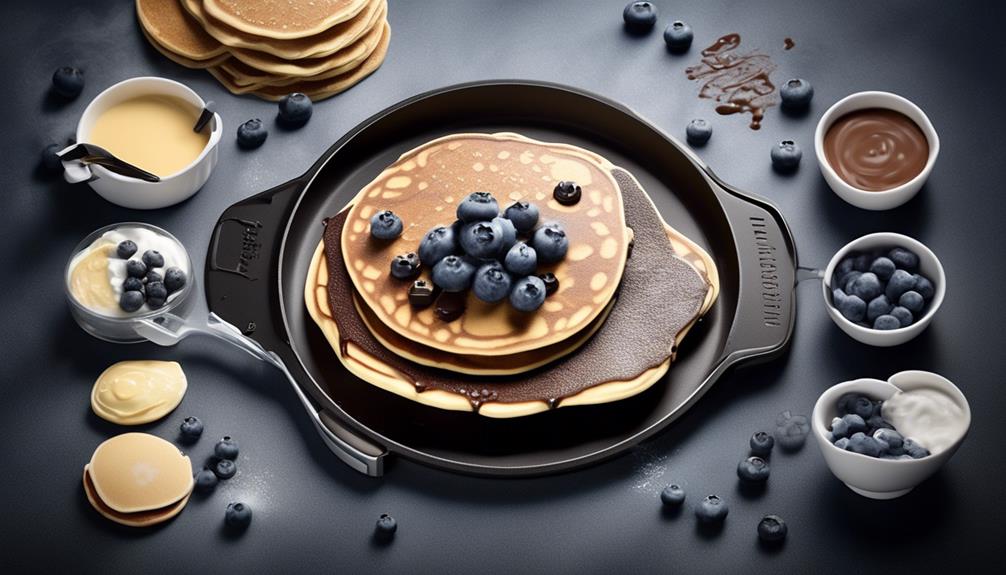
For different types of pancakes, it's important to adjust the griddle temperature accordingly to achieve the desired texture and flavor. When making fluffy pancakes, a lower temperature is ideal to allow the batter to rise and create a light, airy texture. On the other hand, thin pancakes, such as crepes, require a higher temperature for a quick cook that results in a delicate, slightly crispy texture. Additionally, when preparing sweet pancakes like blueberry or chocolate chip, a moderate temperature helps caramelize the sugars in the batter, enhancing the overall flavor. Conversely, savory pancakes like potato or corn cakes benefit from a slightly higher temperature to achieve a golden brown crust while maintaining a moist interior.
| Pancake Type | Texture | Ideal Griddle Temperature |
|---|---|---|
| Fluffy | Light, airy | Low |
| Thin | Delicate, slightly crispy | High |
| Sweet | Caramelized, flavorful | Moderate |
| Savory | Golden brown crust, moist interior | Slightly higher |
Adjusting the griddle temperature based on the specific pancake type is crucial for achieving the perfect texture and flavor, whether it's fluffy vs. thin or sweet vs. savory.
Tips for Maintaining Consistent Temperature
When maintaining the griddle temperature for different types of pancakes, it's essential to employ certain tips to ensure consistency and achieve the desired texture and flavor.
Maintaining heat is crucial for even cooking. One effective tip is to preheat the griddle properly. This allows for an even distribution of heat across the cooking surface, preventing hot spots that can lead to unevenly cooked pancakes.
Additionally, using a griddle with a built-in thermostat or an external thermometer can help in monitoring and maintaining the desired temperature throughout the cooking process.
Another important tip is to adjust the heat as needed. If the griddle temperature seems to be too high or too low, making necessary adjustments can help in achieving consistent results.
Furthermore, avoiding overcrowding the griddle enables better heat circulation, promoting even cooking. By allowing sufficient space between each pancake, the heat is distributed more evenly, resulting in a consistent texture and flavor.
These tips for maintaining consistent temperature on the griddle can greatly contribute to the overall success of pancake preparation.
Frequently Asked Questions
Can I Use a Regular Frying Pan Instead of a Griddle for Making Pancakes?
Yes, you can use a regular frying pan to make pancakes. It should be nonstick and have low sides for easy flipping.
Preheat the pan over medium heat for even cooking and a golden brown color. Adjust the temperature as needed while cooking to prevent burning.
Using a griddle is ideal for making multiple pancakes at once, but a frying pan works well for smaller batches.
How Can I Tell if My Griddle Is Preheated to the Right Temperature for Making Pancakes?
When checking doneness, a helpful statistic to remember is that pancakes are ready to flip when the edges appear set and bubbles form on the surface.
To test the griddle's temperature, a drop of water should sizzle and evaporate upon contact.
Patience in preheating is essential for even cooking.
Our flipping technique involves using a spatula to gently lift and turn the pancake when golden brown.
Should I Use Oil or Butter on the Griddle When Making Pancakes?
We've found that using butter on the griddle is the way to go for pancakes. It adds a rich flavor and helps achieve a golden-brown crust.
As for flipping techniques, we've learned that waiting for bubbles to form on the surface before flipping ensures a perfectly cooked pancake. Gently slide the spatula underneath and swiftly flip to avoid any mishaps.
This technique guarantees a fluffy and evenly cooked pancake every time.
Is It Okay to Use a Griddle on a Gas Stove, or Does It Work Better on an Electric Stove?
We've found that using a griddle on a gas stove can provide more precise temperature control, while an electric stove delivers more consistent heat distribution across the griddle surface.
When it comes to pancake texture, a gas stove allows for quicker adjustments in griddle temperature, which can help achieve the perfect golden-brown finish. However, with an electric stove, the even heat distribution can result in more uniform cooking.
What Are Some Common Mistakes People Make When Using a Griddle for Making Pancakes?
When making pancakes on a griddle, common mistakes can ruin the perfect flip. Flipping too early can lead to undercooked centers. Uneven heat distribution causes inconsistent browning. Using a regular frying pan results in limited space for flipping.
Preheating the griddle is essential for even cooking. Oil provides a higher smoke point than butter. Gas stoves offer quicker temperature adjustments compared to electric stoves.
Mastering these details ensures flawless pancake perfection.
What Temperature Should I Set My Griddle for Perfect Pancakes?
For perfect pancakes, the ideal temperature for pancakes on your griddle is around 375°F. This allows the batter to cook evenly and develop a golden-brown crust without burning. Achieving the right temperature ensures that your pancakes are fluffy on the inside and deliciously crispy on the outside.
Conclusion
In conclusion, finding the right temperature for your griddle is essential for perfect pancakes every time.
By understanding heat zones and adjusting for different pancake types, you can maintain consistent temperature and achieve golden, fluffy pancakes that everyone will love.
So, next time you fire up the griddle, remember to find that sweet spot and get ready to flip some delicious flapjacks.
- About the Author
- Latest Posts
Introducing Ron, the home decor aficionado at ByRetreat, whose passion for creating beautiful and inviting spaces is at the heart of his work. With his deep knowledge of home decor and his innate sense of style, Ron brings a wealth of expertise and a keen eye for detail to the ByRetreat team.
Ron’s love for home decor goes beyond aesthetics; he understands that our surroundings play a significant role in our overall well-being and productivity. With this in mind, Ron is dedicated to transforming remote workspaces into havens of comfort, functionality, and beauty.
Beginners Guides
The Best Time to Cruise for Budget-Friendly Deals
Fulfill your wanderlust dreams without draining your wallet by learning the key to scoring budget-friendly cruise deals.

When it comes to finding budget-friendly cruise deals, timing is key. Imagine setting sail on the crystal blue waters of the Caribbean or exploring the stunning glaciers of Alaska without breaking the bank.
There's a specific window of opportunity that savvy cruisers keep an eye on to secure the best rates and save some serious cash. But how do you know when to book your next adventure to make the most of your budget?
Let's uncover the secrets behind scoring the ultimate cruise deals and making your dream vacation a reality.
Key Takeaways
- Booking during wave season in January to March ensures budget-friendly deals.
- Monitoring prices post-booking for drops leads to potential refunds or upgrades.
- Repositioning cruises in spring and fall offer cost-effective options.
- Leveraging loyalty programs maximizes savings for affordable cruising.
Ideal Seasons for Budget-Friendly Cruises
When seeking budget-friendly cruise deals, timing plays an important role in securing the best value for your money. Shoulder seasons such as September, October, and early December present excellent opportunities for travelers looking for cheaper fares. These off-peak times often offer discounted rates and fewer crowds, making it an ideal choice for budget-conscious individuals.
Additionally, booking during wave season in January and February can lead to significant discounts and promotions, maximizing savings on your cruise vacation.
Repositioning cruises during spring and fall are another fantastic option for savvy travelers seeking affordable deals. These cruises often provide cost-effective choices as cruise lines move their ships between different regions.
Avoiding major holidays and school breaks is also key to securing cheaper cruise fares and ensuring a more relaxed cruising experience. Moreover, sailing from Florida during off-peak times can offer a wide range of options and better deals for those looking to save on their cruise adventures.
Strategies for Booking Affordable Cruises

To secure the best deals on cruises, it's important to employ strategic booking approaches that maximize cost savings and value for your vacation. When aiming for budget-friendly cruise deals, consider the following strategies:
- Booking in Advance: Securing your cruise early, especially during wave season from January to March, can lead to lower rates and additional benefits.
- Monitoring Fare Changes: Keep an eye on fluctuating fares and be ready to book when prices drop to secure the best deal.
- Being Flexible with Travel Dates: Flexibility can be key in finding affordable cruise options, as adjusting your travel dates slightly can result in significant savings.
- Considering Repositioning Cruises: Exploring repositioning cruises or sailing during shoulder seasons can offer unique routes and discounted prices.
- Utilizing Loyalty Programs and Off-Peak Times: Take advantage of loyalty programs, monitor price drops, and consider traveling during off-peak times to maximize your savings on cruise vacations.
Best Times to Score Cruise Deals
During wave season from January to March, travelers can capitalize on the best times to secure budget-friendly cruise deals. Booking well in advance is key to snagging the most favorable timing and rates for your cruise.
Additionally, considering repositioning cruises during the spring and fall can offer discounted prices, making them a great option for those seeking budget-friendly deals. It's also advisable to keep an eye out for price drops even after booking, as this could potentially lead to refunds or upgrades for your cruise experience.
Leveraging loyalty programs or memberships can grant you access to exclusive discounts and savings on your upcoming cruise. By being proactive and strategic in your approach to booking and monitoring deals, you can maximize your chances of finding the best cruise deals that align with your budget and preferences.
Timing Tips for Budget-Friendly Cruises

Let's explore practical strategies for maximizing your savings on budget-friendly cruises through strategic timing tips. When aiming to secure the best cruise deals that align with your budget, consider the following insights:
- Booking in Advance: Take advantage of wave season from January to March to lock in lower rates and secure desirable cabin options.
- Monitoring Prices: Keep an eye on price drops even after booking to potentially benefit from refunds or upgrades, enhancing your overall cruise experience.
- Loyalty Programs: Utilize loyalty programs or memberships to access additional discounts and exclusive perks, making your budget-friendly cruise even more cost-effective.
- Nearby Ports: Opt for cruises departing from nearby ports to save on airfare costs, enabling you to allocate more of your budget towards onboard activities and excursions.
- Discounts Galore: Embrace the array of discounts available during wave season and beyond, ensuring that you snag the best possible deal for your budget-friendly cruise adventure.
When to Book for Cruise Savings
Securing cruise savings hinges on strategic timing and proactive booking practices. To find the best deals, consider booking during wave season from January to March when many cruise lines offer enticing discounts.
Booking early not only guarantees better rates but also provides a wider selection of cabin choices. Keep an eye out for fare changes even after booking, as price drops may occur, presenting an opportunity for additional savings.
While waiting for last-minute deals can sometimes lead to the cheapest rates, this approach often comes with limited cabin availability. To stay informed about price fluctuations, utilize tools like the Shipmate app and Cruise Critic for efficient monitoring.
Conclusion
To summarize, cruising during the off-peak season can help us save some serious dough. Booking early during wave season is key to scoring those sweet deals.
So, let's set sail and make some memories without breaking the bank. Remember, early bird gets the worm – or should I say, the cruise discount!
- About the Author
- Latest Posts
Introducing Ron, the home decor aficionado at ByRetreat, whose passion for creating beautiful and inviting spaces is at the heart of his work. With his deep knowledge of home decor and his innate sense of style, Ron brings a wealth of expertise and a keen eye for detail to the ByRetreat team.
Ron’s love for home decor goes beyond aesthetics; he understands that our surroundings play a significant role in our overall well-being and productivity. With this in mind, Ron is dedicated to transforming remote workspaces into havens of comfort, functionality, and beauty.
Beginners Guides
Best Time to Go on an Alaskan Cruise for Wildlife Watching
Get ready to discover the optimal time for wildlife enthusiasts to embark on an Alaskan cruise – the ultimate season for extraordinary encounters awaits!

One could contend that any time of year is fitting for an Alaskan cruise, but if you genuinely want to maximize your wildlife watching opportunities, timing is key.
While many months offer glimpses of nature's wonders, there is a particular period that stands out above the rest.
Join us as we explore the intricacies of the Alaskan wilderness and uncover the secrets of when to set sail on a journey that promises unforgettable encounters with some of the most magnificent creatures on earth.
Key Takeaways
- Prime months for wildlife viewing in Alaska are May, June, and September.
- Peak whale watching season is from mid-June to August.
- Best time for bear spotting is between July and early September.
- Ideal months for bald eagle sightings in southeast Alaska are from May to September.
Prime Months for Wildlife Viewing
During the prime months of May, June, and September, Alaska offers the best conditions for wildlife enthusiasts to observe a diverse array of animals in their natural habitats. June marks the beginning of summer, a time when the landscape comes alive with the sights and sounds of wildlife.
July and August are ideal for witnessing brown bears fishing for salmon and catching glimpses of majestic moose roaming through the wilderness. These months provide ample opportunities for up-close wildlife viewing experiences, especially during the salmon run when bears gather along the rivers to feast.
As the summer changes into September, visitors can look forward to spotting humpback whales during their annual migration, as well as witnessing the spectacular spawning salmon and caribou herds moving across the land. The shoulder seasons offer a unique chance to explore Alaska inside and out, with fewer crowds and mosquitoes, making it an ideal time for wildlife enthusiasts to immerse themselves in the natural beauty of the region.
Peak Whale Watching Season

In the peak whale watching season in Alaska, which typically spans from mid-June to August, enthusiasts have the best opportunities to witness humpback whales and other species in their natural habitat. Humpback whales are commonly sighted during the summer months as they feed on small fish and krill.
Killer whales, also known as orcas, are best spotted in May and June near Ketchikan, Juneau, and Seward, hunting for seals and other marine mammals. Grey whales migrate to southern Alaska in late spring, showcasing their impressive breaching behaviors.
Blue whales, the largest animals on Earth, may be seen in July and August, traveling through Alaskan waters in search of food. Whale sightings can vary depending on the specific month of your Alaskan cruise, so choosing the right time within the peak season is important for maximizing wildlife watching opportunities while sailing through these majestic waters.
Best Time for Bear Spotting
Ideally situated between July and early September, the peak time for bear spotting in Alaska coincides with the salmon influx that attracts these magnificent creatures to the creeks and streams of the region. During this period, Grizzly bears can be observed in their natural habitat, offering a thrilling experience for wildlife enthusiasts. Royal Caribbean Cruise Tours in Alaska often include bear viewing excursions, enhancing the opportunity to witness these powerful animals up close. For best bear sightings, consider visiting during the salmon run in July, a time when bears are actively hunting for fish in creeks and streams, particularly in locations like Ketchikan. Alaska's diverse landscapes and ecosystems provide ample opportunities for bear viewing, from observing black bears to encountering majestic brown bears. Whether through guided tours or remote float plane trips, Alaska offers a range of experiences to witness these iconic creatures in their element.
| Best Time for Bear Spotting | |
|---|---|
| July | Salmon run |
| Early September | Grizzly bears |
| Creeks | Streams |
| Ketchikan | Royal Caribbean Cruise Tours |
Ideal Months for Eagle Sightings

The peak months for perfect bald eagle sightings in southeast Alaska are from May to September. During these months, as part of an Alaska cruise, birdwatching enthusiasts can witness the majestic bald eagles in their natural habitat. Southeast Alaska, home to around 30,000 bald eagles, offers ample opportunities for wildlife watching, especially near bodies of water where eagles are commonly spotted.
The Sitka Cultural Discovery excursion is a great way to observe bald eagles up close, as they're frequently seen near streams and bodies of water. With approximately 470 bird species in the region, including the iconic bald eagle, Southeast Alaska provides a diverse birdwatching experience for nature lovers.
Whether soaring through the skies or perched on branches overlooking the water, bald eagles are a common sight throughout the summer months in this pristine Alaskan wilderness. For those seeking unforgettable eagle sightings and a chance to immerse themselves in Alaska's rich wildlife, visiting during the peak months offers an unparalleled birdwatching experience.
Optimal Time for Otter Encounters
Best timing for observing otters in Alaska ranges from early spring through the end of July. During this period, the chances of encountering these enchanting creatures are at their peak. Here are some key points to keep in mind for prime otter encounters during your Alaskan cruise:
- Steller sea lions: While otters are more prevalent during spring and early summer, Steller sea lions can be spotted year-round in Alaska. Keep an eye out for these majestic marine mammals as they often share habitats with otters.
- Streams and creeks: Otters are frequently seen near streams and creeks, making these areas prime locations for wildlife watching. Cruise along these waterways to increase your chances of a memorable otter sighting.
- Wildlife tours: Participating in wildlife tours in Alaska can enhance your otter encounters. These tours often provide opportunities to get up close to Steller sea lions, with otters sometimes making surprise appearances alongside them.
- Sea otters near the ocean: Whether near the ocean or inland water bodies, otters are adaptable creatures that thrive in various environments. Keep a lookout for these playful animals during your Alaskan cruise for a truly immersive wildlife experience.
Conclusion
To sum up, our investigation confirms that the best time to go on an Alaskan cruise for wildlife watching is indeed during the peak season of July.
The abundance of wildlife sightings, perfect weather conditions, and increased chances of spotting bears, whales, eagles, otters, and other fascinating creatures make July the ideal month for an unforgettable Alaskan wildlife experience.
Don't miss out on this prime opportunity to witness the wonders of nature in their natural habitat.
- About the Author
- Latest Posts
Introducing Ron, the home decor aficionado at ByRetreat, whose passion for creating beautiful and inviting spaces is at the heart of his work. With his deep knowledge of home decor and his innate sense of style, Ron brings a wealth of expertise and a keen eye for detail to the ByRetreat team.
Ron’s love for home decor goes beyond aesthetics; he understands that our surroundings play a significant role in our overall well-being and productivity. With this in mind, Ron is dedicated to transforming remote workspaces into havens of comfort, functionality, and beauty.
Beginners Guides
The Best Time to Go on an Alaskan Cruise
Journey through the Alaskan wilderness at its prime, uncovering the unique factor that sets the best time to go on an Alaskan cruise apart.

When considering the best time to start on an Alaskan cruise, May and September emerge as the top contenders. These shoulder seasons present an array of advantages that cater to both seasoned travelers and those new to cruising.
With the promise of better deals, reduced crowds, and lower prices, an Alaskan adventure during these months is not only cost-effective but also offers a more intimate experience of the region's breathtaking beauty.
However, there is one important factor that sets apart these shoulder seasons from the rest, and it's not just about cost or crowd size.
Key Takeaways
- Late-May to mid-June: prime for wildlife photography and bear sightings.
- Mid-June to August: ideal weather, ample sunlight, and wildlife encounters.
- Early September: peaceful cruise experience with fall foliage views.
- Late September: witness the mesmerizing Northern Lights on Alaskan cruises.
Best Time for Wildlife & Activities
In late-May to mid-June, we find the ideal time for capturing stunning wildlife photography in Alaska. As the daylight hours extend, providing ample opportunities to witness the natural beauty, this period is perfect for spotting humpback whales breaching the waters or observing bears feasting on the abundance of salmon. Cruise excursions during this time offer unforgettable experiences, allowing you to witness the wildlife in their natural habitat.
Denali National Park opens its doors to wildlife enthusiasts in mid-May, providing a chance to explore the diverse flora and fauna. Additionally, different species of salmon reach their peak at varying months, creating a dynamic environment for wildlife viewing. For those interested in experiencing the vibrant fall foliage, early to mid-September showcases Alaska's landscape in a breathtakingly colorful display, attracting wildlife like never before. Whether you're an avid photographer or a wildlife enthusiast, late spring to early summer is the best time to commence on an Alaskan adventure.
Ideal Months for Good Weather

Mid-June to August stands out as the prime window for experiencing excellent weather conditions during an Alaskan cruise, offering temperatures ranging from 50-70°F and up to 22 hours of sunlight, ideal for enjoying outdoor activities and remarkable wildlife sightings. The pleasant weather in mid-summer guarantees a comfortable and enjoyable cruise experience amidst Alaska's stunning natural surroundings. This period is perfect for wildlife viewing, with sightings of brown bears, moose, whales (belugas, humpbacks, orcas), seals, and dolphins being quite common.
- Warm temperatures ranging from 50-70°F
- Up to 22 hours of sunlight
- Excellent wildlife viewing opportunities
- Ideal conditions for outdoor activities and wildlife spotting
Choosing to cruise between mid-June and August guarantees a delightful experience in Alaska, with the perfect blend of comfortable weather, extended daylight hours, and the chance to immerse yourself in the beauty of the region's diverse wildlife and landscapes. This period is widely regarded as the best time for Alaska cruises, offering opportunities to explore stunning glaciers, national parks, and charming coastal towns. Travelers can spot humpback whales, bald eagles, and grizzly bears as they revel in the breathtaking scenery. Whether you’re hiking through verdant forests or simply soaking up the awe-inspiring views from the ship’s deck, an Alaska cruise during this peak season promises unforgettable memories.
Optimal Time for Avoiding Crowds
For a peaceful Alaskan cruise experience with fewer crowds and wallet-friendly options, consider setting sail in early September. This time marks the change from summer to autumn, offering stunning views of fall foliage without the hustle and bustle of peak tourist season.
Late September also presents an excellent opportunity to witness wildlife in their natural habitat. Imagine catching a glimpse of majestic humpback whales breaching the surface, observing the mesmerizing sight of spawning salmon, or marveling at the sight of caribou starting on their annual migration.
The cooler temperatures create a comfortable setting for exploration, allowing you to enjoy the serenity of Alaska without the summer crowds. With fewer tourists around, you can immerse yourself in the beauty of the landscape and wildlife without distractions.
Prime Time for Northern Lights

With the arrival of late September, prepare to be mesmerized by the celestial dance of the Northern Lights on your Alaskan cruise. As solar wind particles collide with air molecules, the Arctic sky lights up with unbelievable colors, creating a magical display that will leave you in awe. Alaska offers great viewing opportunities for the Northern Lights, especially during the late September timeframe. Although the lights are more brilliant in winter, you can still witness their beauty by the second week of September.
- Experience the breathtaking colors of the Northern Lights in the Alaskan sky.
- Marvel at the celestial dance created by solar wind particles and air molecules.
- Take advantage of the excellent viewing opportunities that Alaska provides for this natural spectacle.
- Enjoy the brilliant display of the Northern Lights even in late September, making your Alaskan cruise truly unforgettable.
Peak Wildlife Viewing Seasons
As we move from the mesmerizing spectacle of the Northern Lights to the enchanting domain of Alaska's wildlife, late May beckons as the prime time for experiencing the vibrant array of creatures that call this wilderness home.
During late May to mid-June, Alaska comes alive with wildlife awakening. Witness salmon runs, mothers with calves, and a variety of animals like moose, sheep, mountain goats, and black bears roaming the landscape. The cooler temperatures and increased daylight create the perfect conditions for diverse wildlife sightings.
This period offers a unique opportunity to observe Alaska's natural inhabitants without the peak tourist crowds, allowing for a more intimate and immersive experience. Whether you're a wildlife enthusiast or simply appreciate the beauty of nature, late May to mid-June provides a window into the rich tapestry of Alaska's ecosystem.
Conclusion
As we sail through the breathtaking Alaskan waters, surrounded by majestic wildlife and stunning landscapes, we can't help but feel the magic of this unique experience.
But there's one more surprise waiting for us as the sun sets on the horizon, painting the sky with hues of pink and purple.
Stay tuned for the grand finale of our Alaskan adventure, where nature puts on a show like no other.
Get ready to be amazed!
- About the Author
- Latest Posts
Introducing Ron, the home decor aficionado at ByRetreat, whose passion for creating beautiful and inviting spaces is at the heart of his work. With his deep knowledge of home decor and his innate sense of style, Ron brings a wealth of expertise and a keen eye for detail to the ByRetreat team.
Ron’s love for home decor goes beyond aesthetics; he understands that our surroundings play a significant role in our overall well-being and productivity. With this in mind, Ron is dedicated to transforming remote workspaces into havens of comfort, functionality, and beauty.
-

 Vetted2 weeks ago
Vetted2 weeks ago15 Best Drip Irrigation Systems to Keep Your Garden Thriving
-

 Vetted1 day ago
Vetted1 day ago15 Best Sports Laundry Detergents for Keeping Your Activewear Fresh and Clean
-

 Vetted3 days ago
Vetted3 days ago15 Best Tall Toilets for Seniors That Combine Comfort and Safety
-

 Vetted1 week ago
Vetted1 week ago15 Best Dish Scrubbers to Keep Your Kitchen Sparkling Clean
-
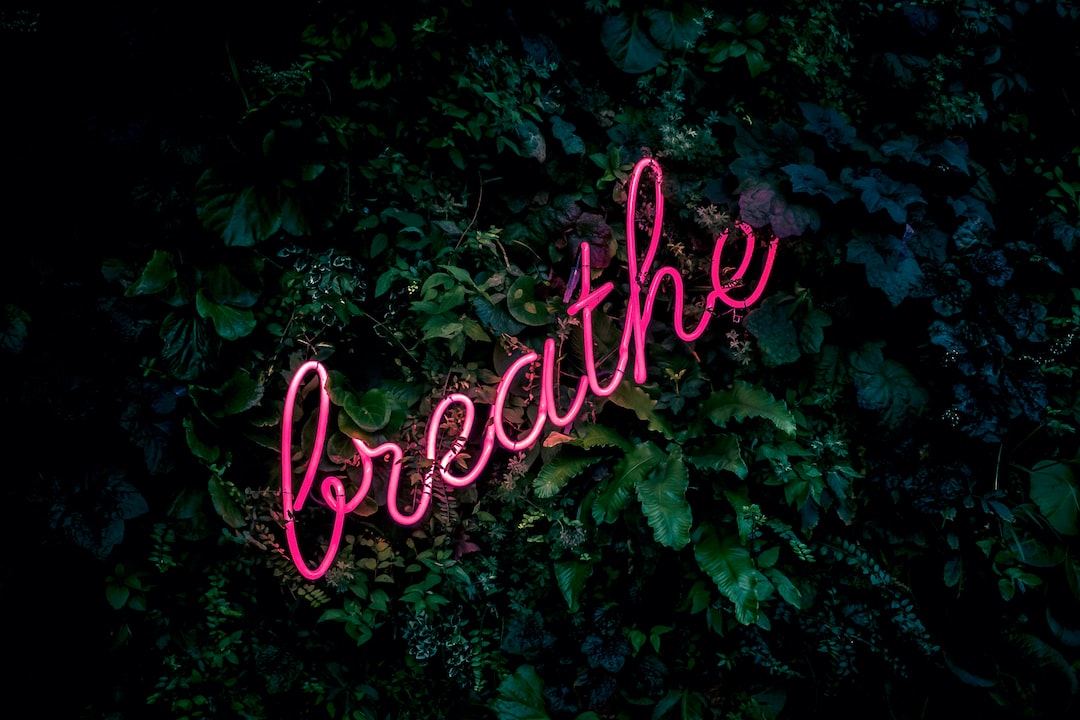
 Beginners Guides3 weeks ago
Beginners Guides3 weeks agoDesigning Your Retreat Center – Essential Tips
-
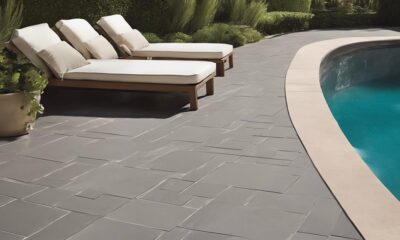
 Vetted3 weeks ago
Vetted3 weeks ago15 Best Tile Adhesives for Outdoor Use – Top Picks for Durable and Weather-Resistant Installations
-

 Beginners Guides3 weeks ago
Beginners Guides3 weeks agoAre Retreats Profitable
-

 Decor1 week ago
Decor1 week agoWhat Is Eclectic Home Decor






















